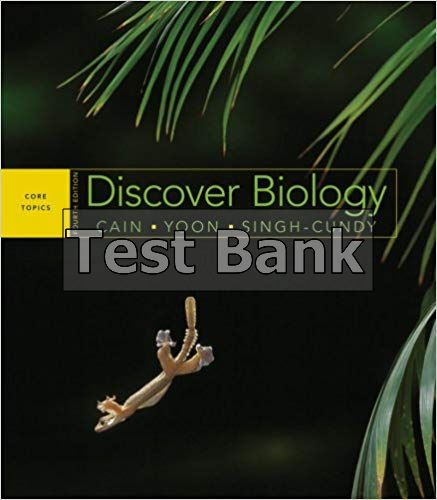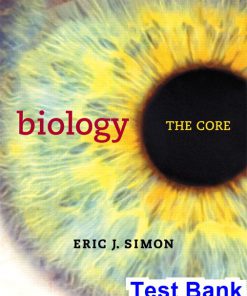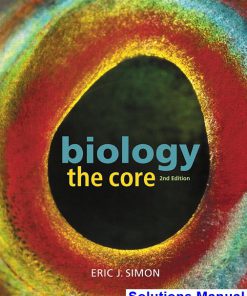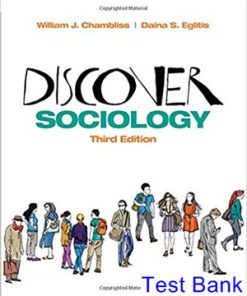Discover Biology Core Topics 4th Edition Cain Test Bank
You may also like
-
$26.50
$50.00 -
$26.50
$50.00
Discover Biology Core Topics 4th Edition Cain Test Bank

Product details:
- ISBN-10 : 0393931617
- ISBN-13 : 978-0393931617
- Author: Michael L. Cain
Discover Biology helps students become biologically literate studentsto progress from science to scientific literacy.Written from the ground up for nonmajors, Discover Biology is the only introductory biology textbook to present consistently applied features in each chapter that not only demonstrate biologys everyday relevance, but teach students how to move from simply understanding core biological concepts to actively applying those concepts to our rapidly changing world. Discover Biology helps students become biologically literate studentsto progress from science to scientific literacy.
Table contents:
- Chapter 1 – The Nature of Science and the Characteristics of Life
- 1.1 – The Nature of Science
- 1.2 – The Process of Science
- 1.3 – Scientific Facts and Theories
- 1.4 – The Characteristics of Living Organisms
- 1.5 – Biological Evolution and the Unity and Diversity of Life
- 1.6 – The Biological Hierarchy
- Chapter 2 – The Chemistry of Life
- 2.1 – Matter, Elements, and Atomic Structure
- 2.2 – The Bonds That Link Atoms
- 2.3 – The Special Properties of Water
- 2.4 – Chemical Reactions
- 2.5 – The pH Scale
- 2.6 – The Chemical Building Blocks of Life
- 2.7 – Carbohydrates
- 2.8 – Proteins
- 2.9 – Lipids
- 2.10 – Nucleotides and Nucleic Acids
- Chapter 3 – Cell Structure and Internal Compartments
- 3.1 – Cells: The Smallest Units of Life
- 3.2 – The Plasma Membrane
- 3.3 – Prokaryotic and Eukaryotic Cells
- 3.4 – Internal Compartments of Eukaryotic Cells
- 3.5 – The Cytoskeleton
- Chapter 4 – Cell Membranes, Transport, and Communication
- 4.1 – The Plasma Membrane as Gate and Gatekeeper
- 4.2 – Osmosis
- 4.3 – Facilitated Membrane Transport
- 4.4 – Exocytosis and Endocytosis
- 4.5 – Cellular Connections
- 4.6 – Cell Signaling
- Chapter 5 – Energy Metabolism, and Enzymes
- 5.1 – The Role of Energy in Living Systems
- 5.2 – Metabolism
- 5.3 – Enzymes
- 5.4 – Metabolic Pathways
- Chapter 6 – Photosynthesis and Cellular Respiration
- 6.1 – Molecular Energy Carriers
- 6.2 – An Overview of Photosynthesis and Cellular Respiration
- 6.3 – Photosynthesis: Energy from Sunlight
- 6.4 – Cellular Respiration: Energy from Food
- Chapter 7 – Cell Division
- 7.1 – Why Cells Divide
- 7.2 – The Cell Cycle
- 7.3 – The Chromosomal Organization of Genetic Material
- 7.4 – Mitosis and Cytokinesis: From One Cell to Two Identical Cells
- 7.5 – Meiosis: Halving the Chromosome Set to Make Gametes
- Chapter 8 – Cancer and Human Health
- 8.1 – Cancer: Good Cells Gone Bad
- 8.2 – Cancer-Critical Genes
- 8.3 – The Progression to Cancer
- 8.4 – Treatment and Prevention
- Chapter 9 – Patterns of Inheritance
- 9.1 – Principles of Genetics: An Overview
- 9.2 – Basic Patterns of Inheritance
- 9.3 – Mendel’s Laws of Inheritance
- 9.4 – Extensions of Mendel’s Laws
- Chapter 10 – Chromosomes and Human Genetics
- 10.1 – The Role of Chromosomes in Inheritance
- 10.2 – Genetic Linkage and Crossing-Over
- 10.3 – Human Genetic Disorders
- 10.4 – Autosomal Inheritance of Single-Gene Mutations
- 10.5 – Sex-Linked Inheritance of Single-Gene Mutations
- 10.6 – Inherited Chromosomal Abnormalities
- Chapter 11 – DNA and Genes
- 11.1 – An Overview of DNA and Genes
- 11.2 – The Three-Dimensional Structure of DNA
- 11.3 – How DNA Is Replicated
- 11.4 – Repairing Replication Errors and Damaged DNA
- 11.5 – Genome Organization
- 11.6 – DNA Packing in Eukaryotes
- 11.7 – Patterns of Gene Expression
- Chapter 12 – From Gene to Protein
- 12.1 – How Genes Work
- 12.2 – Transcription: Information Flow from DNA to RNA
- 12.3 – The Genetic Code
- 12.4 – Translation: Information Flow from mRNA to Protein
- 12.5 – The Effect of Mutations on Protein Synthesis
- 12.6 – How Cells Control Gene Expression
- Chapter 13 – DNA Technology
- 13.1 – The Brave New World of DNA Technology
- 13.2 – DNA Fingerprinting
- 13.3 – Genetic Engineering
- 13.4 – Reproductive Cloning of Animals
- 13.5 – Stem Cells: Dedicated to Division
- 13.6 – Human Gene Therapy
- 13.7 – Ethical and Social Dimensions of DNA Technology
- 13.8 – A Closer Look at Some Tools of DNA Technology
- Chapter 14 – How Evolution Works
- 14.1 – Evolution and Natural Selection
- 14.2 – Mechanisms of Evolutionary Change
- 14.3 – Natural Selection Leads to Adaptive Evolution
- 14.4 – Adaptations
- 14.5 – Sexual Selection
- 14.6 – The Evidence for Biological Evolution
- 14.7 – The Impact of Evolutionary Thought
- Chapter 15 – The Origin of Species
- 15.1 – What Are Species?
- 15.2 – Speciation: Generating Biodiversity
- 15.3 – Adaptive Radiations: Increases in the Diversity of Life
- 15.4 – Evolution Can Explain the Unity and Diversity of Life
- 15.5 – Rates of Speciation
- Chapter 16 – The Evolutionary History of Life
- 16.1 – Macroevolution: Large-Scale Body Changes
- 16.2 – The Fossil Record: A Guide to the Past
- 16.3 – The History of Life on Earth
- 16.4 – The Effects of Plate Tectonics
- 16.5 – Mass Extinctions: Worldwide Losses of Species
- 16.6 – Rapid Macroevolution through Differential Gene Expression
- 16.7 – Phylogenetics: Reconstructing Evolutionary Relationships
- Chapter 17 – Bacteria, Archaea, and Viruses
- 17.1 – The Diversity of Life
- 17.2 – Bacteria and Archaea: Tiny, Successful, and Abundant
- 17.3 – How Prokaryotes Affect Our World
- 17.4 – Viruses: Nonliving Infectious Agents
- Chapter 18 – Protista, Plantae, and Fungi
- 18.1 – The Dawn of Eukarya
- 18.2 – Protista: The First Eukaryotes
- 18.3 – Plantae: The Green Mantle of Our World
- 18.4 – Fungi: A World of Decomposers
- 18.5 – Lichens and Mycorrhizae: Collaborations between Kingdoms
- Chapter 19 – Animalia
- 19.1 – The Evolutionary Origins of Animalia
- 19.2 – Characteristics of Animals
- 19.3 – The First Invertebrates: Sponges, Jellyfish, and Relatives
- 19.4 – The Protostomes
- 19.5 – The Deuterostomes
- 19.6 – Chordates like Us: The Vertebrates
- Chapter 20 – The Biosphere
- 20.1 – Ecology: Understanding the Interconnected Web
- 20.2 – Climate’s Large Effect on the Biosphere
- 20.3 – Terrestrial Biomes
- 20.4 – Aquatic Biomes
- Chapter 21 – Growth of Populations
- 21.1 – What Is a Population?
- 21.2 – Changes in Population Size
- 21.3 – Exponential Growth
- 21.4 – Logistic Growth and the Limits on Population Size
- 21.5 – Applications of Population Ecology
- Chapter 22 – Animal Behavior
- 22.1 – Sensing and Responding: The Nature of Behavioral Responses
- 22.2 – Fixed and Learned Behaviors in Animals
- 22.3 – Social Behavior in Animals
- 22.4 – Facilitating Behavioral Interactions through Communication
- 22.5 – Mating Behaviors
- Chapter 23 – Ecological Communities
- 23.1 – Species Interactions
- 23.2 – How Species Interactions Shape Communities
- 23.3 – How Communities Change over Time
- 23.4 – Human Impacts on Community Structure
- Chapter 24 – Ecosystems
- 24.1 – How Ecosystems Function: An Overview
- 24.2 – Energy Capture in Ecosystems
- 24.3 – Energy Flow through Ecosystems
- 24.4 – Biogeochemical Cycles
- 24.5 – Human Actions Can Alter Ecosystem Processes
- Chapter 25 – Global Change
- 25.1 – Land and Water Transformation
- 25.2 – Changes in the Chemistry of Earth
- 25.3 – Human Impacts on the Global Carbon Cycle
- 25.4 – Climate Change
- 25.5 – Timely Action Can Avert the Worst-Case Scenarios
- Index
- Glossary
- Credits
People also search:
discover 4-h curriculum
3 topics in biology
3 subtopics for biology foundations
4 big ideas in ap biology
5 core concepts of biology examples












